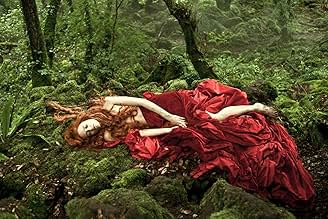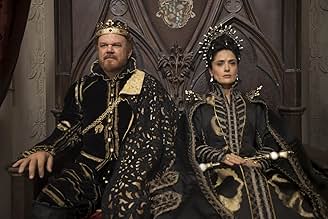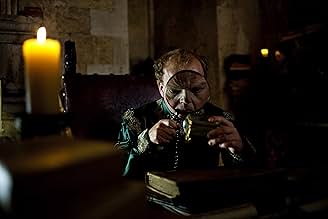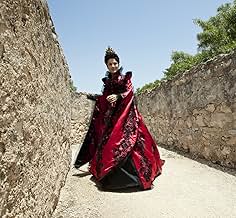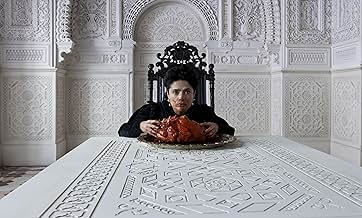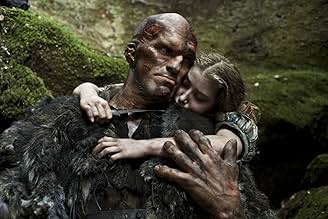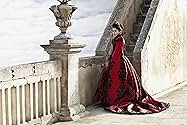Tale of Tales : Le Conte des contes
Titre original : Il racconto dei racconti - Tale of Tales
De la quête de la reine de Longtrellis jusqu'aux deux soeurs mystérieuses qui provoquèrent la passion d'un roi, en passant par le roi des Highhills obsédé par une puce géante, ces récits s'i... Tout lireDe la quête de la reine de Longtrellis jusqu'aux deux soeurs mystérieuses qui provoquèrent la passion d'un roi, en passant par le roi des Highhills obsédé par une puce géante, ces récits s'inspirent des contes de Giambattista Basile.De la quête de la reine de Longtrellis jusqu'aux deux soeurs mystérieuses qui provoquèrent la passion d'un roi, en passant par le roi des Highhills obsédé par une puce géante, ces récits s'inspirent des contes de Giambattista Basile.
- Réalisation
- Scénario
- Casting principal
- Récompenses
- 21 victoires et 15 nominations au total
Avis à la une
The royal court roars with laughter. A group of jesters grin and jeer at one another, do cartwheels, breathe fire. In the midst of all this mirth, the Queen sits sad and silent on her throne. Her eyes fall on one of the players and suddenly she runs off, distraught. The King chases after her, shouting that he is sorry, that he did not know. His apologies fall on deaf ears.
So begins Tale of Tales, Matteo Garrone's visually striking, but ultimately uninspiring adaptation of the Pentamerone, a book of Italian folk stories collected in the 17th century.The film cuts between three separate narrative strands, linked together by the unifying theme of all-consuming obsession. One tale centres around a monarch mad with lust, and two crones in his kingdom who desire only to be young again. Another depicts a woman who will do anything for motherhood. The third tale introduces us to a king's unhealthy fascination with a flea, and an ogre unable to set free his reluctant and unhappy bride.
Fairy tales these may be, but their delightfully disturbing content ensures that they are not meant for children. (At least by modern, if not by 17th century standards – the Pentamerone, just as full of sex and violence as Garrone's 15 rated film, was subtitled 'Entertainment for Little Ones'). Yet even though Tale of Tales is too graphic and gruesome for kids and is clearly aimed at older audiences, it remains too childishly straightforward to be captivating. I would have needed either more nuance or more mystery and suggestion for the film to draw me in and immerse me in its world. There are, for instance, scenes where characters morph into a different physical shape. Had these transformations remained unexplained by the narrative they would have evoked a sense of wonder and significance, like visual poems hinting at some elusive but compelling underlying idea. Instead, the characters transform because a magician cast a spell, and there is nothing to think about. It is the kind of simple cause and effect storytelling with a clear moral – for all three narrative strands put forward the idea that 'obsession is not good for you' – which works so well for children's stories, but is too obvious to really interest adults.
To be fair, it was never Garrone's intention to prompt intellectual engagement with Tale of Tales. 'Don't try to understand it. Just feel it, like when you are standing in front of a painting. Follow the characters, take the journey, feel the emotion,' the director said in a Guardian interview. But the characters are too one-dimensional to seem real, and I found it hard to care about their lives or fates. They also speak far too much to function well as figures onto whom one can project emotion, like when one is standing in front of a painting. It should have been show not tell, with the camera lingering on the characters' facial expressions, and allowing spectators to empathise and identify with them. Instead, feelings, from love to longing, are spoken – 'He's like a brother to me', 'I want to be young again' – and the action moves forward.
Less would have been more, with Tale of Tales. The power of the film lies in its visuals, which are beguiling, gorgeous and grotesque. The dialogues and narrative explanations serve only to trivialise the images, lessening the overall effect of the film. The trailer for Tale of Tales, a succession of visuals set to nothing but music,is better than the film itself.
So begins Tale of Tales, Matteo Garrone's visually striking, but ultimately uninspiring adaptation of the Pentamerone, a book of Italian folk stories collected in the 17th century.The film cuts between three separate narrative strands, linked together by the unifying theme of all-consuming obsession. One tale centres around a monarch mad with lust, and two crones in his kingdom who desire only to be young again. Another depicts a woman who will do anything for motherhood. The third tale introduces us to a king's unhealthy fascination with a flea, and an ogre unable to set free his reluctant and unhappy bride.
Fairy tales these may be, but their delightfully disturbing content ensures that they are not meant for children. (At least by modern, if not by 17th century standards – the Pentamerone, just as full of sex and violence as Garrone's 15 rated film, was subtitled 'Entertainment for Little Ones'). Yet even though Tale of Tales is too graphic and gruesome for kids and is clearly aimed at older audiences, it remains too childishly straightforward to be captivating. I would have needed either more nuance or more mystery and suggestion for the film to draw me in and immerse me in its world. There are, for instance, scenes where characters morph into a different physical shape. Had these transformations remained unexplained by the narrative they would have evoked a sense of wonder and significance, like visual poems hinting at some elusive but compelling underlying idea. Instead, the characters transform because a magician cast a spell, and there is nothing to think about. It is the kind of simple cause and effect storytelling with a clear moral – for all three narrative strands put forward the idea that 'obsession is not good for you' – which works so well for children's stories, but is too obvious to really interest adults.
To be fair, it was never Garrone's intention to prompt intellectual engagement with Tale of Tales. 'Don't try to understand it. Just feel it, like when you are standing in front of a painting. Follow the characters, take the journey, feel the emotion,' the director said in a Guardian interview. But the characters are too one-dimensional to seem real, and I found it hard to care about their lives or fates. They also speak far too much to function well as figures onto whom one can project emotion, like when one is standing in front of a painting. It should have been show not tell, with the camera lingering on the characters' facial expressions, and allowing spectators to empathise and identify with them. Instead, feelings, from love to longing, are spoken – 'He's like a brother to me', 'I want to be young again' – and the action moves forward.
Less would have been more, with Tale of Tales. The power of the film lies in its visuals, which are beguiling, gorgeous and grotesque. The dialogues and narrative explanations serve only to trivialise the images, lessening the overall effect of the film. The trailer for Tale of Tales, a succession of visuals set to nothing but music,is better than the film itself.
This movie is a pure piece of beauty. The direction is amazing, the photography is beyond perfection and the music is inspiring. The locations are unusual and yet are all in Italy. Of course, since the movie is an intersection three fairy tales (not for children, as they're pretty harsh), don't expect the most intriguing plot ever, but its execution has been magistral. I did not give 10 because of the screenplay, which is sometimes a little predictable, and because of the acting, which is extremely heterogeneous across actors: great Salma Hayek, Toby Jones, John Reilly and the Lees brothers, but the others a little less. All in all, I definitely recommend to see this movie.
Greetings again from the darkness. Fairy tales have long been a fruitful source for movie material. Some, like Disney productions, land gently on the family/children end of the scale; while others like the Brothers Grimm material are much darker and adult in nature. And now, along comes director Matteo Garrone and his blending of three stories loosely based on the 17th century tales published by Giambattista Basile
and "black comedy" falls short as a description.
Mr. Garrone is best known for his chilling look at an Italian crime family in the award winning Gomorrah (2008), so a trilogy of demented monarchial fantasies may seem a bit outside his comfort zone but grab ahold of your crown jewels and be ready for just about anything.
A very strong opening leads us into the first story about a King (John C Reilly) and Queen (Salma Hayek) who are by no one's definition, the perfect couple. The Queen's inability to have children leads her to strike a deal with a Faustian seer who promises a baby to the royal couple. The only catch is that the King must kill a sea monster, and the Queen must eat its heart after it's properly prepared by a virgin. Yep, it's pretty dark and pretty odd. Of course, as with all actions, there are consequences (albino twins of different mothers) some of which are not so wonderful.
The second story involves a lecherous King (Vincent Cassel) who falls in love with a local woman based solely on her singing voice. Much deceit follows and the actions of two sisters (played by 3 actresses – Hayley Carmichael, Stacy Martin, Shirley Henderson) and some supernatural aging products lead to a twisty story of romance that can't possibly end well for anyone involved.
The third of our 3-headed story is the strangest of all, as a King (Toby Jones) nurtures a pet flea until it grows to behemoth size. Yes, a pet flea would be considered unusual, but eclipsing even that in uniqueness is the King's willingness to offer the hand of his daughter (Bebe Cave) in marriage to a frightening ogre who lives a solitary life in the mountains.
These three stories are interwoven so that we are bounced from one to another with little warning which seems only fitting given the material. Knowing the theme of the three stories does not prepare one for the details – neither the comedy, nor the dramatic turns. All actors approach the material with deadpan seriousness which adds to the feeling of a Grimm Brothers and Monty Python mash-up.
Alexandre Desplat provides the perfect score for this oddity, though the audience may be limited to those who can appreciate grotesque sequences assembled with the darkest of comedy. The moral to these stories may be difficult to quantify; however, it's a reminder that actions beget consequences no matter the time period.
Mr. Garrone is best known for his chilling look at an Italian crime family in the award winning Gomorrah (2008), so a trilogy of demented monarchial fantasies may seem a bit outside his comfort zone but grab ahold of your crown jewels and be ready for just about anything.
A very strong opening leads us into the first story about a King (John C Reilly) and Queen (Salma Hayek) who are by no one's definition, the perfect couple. The Queen's inability to have children leads her to strike a deal with a Faustian seer who promises a baby to the royal couple. The only catch is that the King must kill a sea monster, and the Queen must eat its heart after it's properly prepared by a virgin. Yep, it's pretty dark and pretty odd. Of course, as with all actions, there are consequences (albino twins of different mothers) some of which are not so wonderful.
The second story involves a lecherous King (Vincent Cassel) who falls in love with a local woman based solely on her singing voice. Much deceit follows and the actions of two sisters (played by 3 actresses – Hayley Carmichael, Stacy Martin, Shirley Henderson) and some supernatural aging products lead to a twisty story of romance that can't possibly end well for anyone involved.
The third of our 3-headed story is the strangest of all, as a King (Toby Jones) nurtures a pet flea until it grows to behemoth size. Yes, a pet flea would be considered unusual, but eclipsing even that in uniqueness is the King's willingness to offer the hand of his daughter (Bebe Cave) in marriage to a frightening ogre who lives a solitary life in the mountains.
These three stories are interwoven so that we are bounced from one to another with little warning which seems only fitting given the material. Knowing the theme of the three stories does not prepare one for the details – neither the comedy, nor the dramatic turns. All actors approach the material with deadpan seriousness which adds to the feeling of a Grimm Brothers and Monty Python mash-up.
Alexandre Desplat provides the perfect score for this oddity, though the audience may be limited to those who can appreciate grotesque sequences assembled with the darkest of comedy. The moral to these stories may be difficult to quantify; however, it's a reminder that actions beget consequences no matter the time period.
It's a fantastic audio-visual journey that takes you into a world of medieval fantasies full of all the classical elements but with fresh stories and views. If you enjoy the work of Paolo Sorrentino (2013 Oscar for "La grande bellezza") you will love this film for it's masterful craft of building a world within. Only Salma Hayek delivers a disappointing performance: Stiff and uninspired. Pictures, music as well as sound design and costumes (not to mention the practical effects) are all stunning! Italy (with the help of France and the UK) delivers once again a masterpiece on the very tight budget of only 12 million uros while the rest of European cinema is sleeping.
Warning; I am going to gush heavily about this movie because, yes, it is one of the most impressive films I have seen in my entire life.
I saw this movie being advertised on a West Village theater marquee and I thought, why not, having no idea what the film was about. The poster was provocative, and piqued my interest as someone that enjoys horror, blood and gore. Yes, there are some horrific elements, some segments that might be considered "gory" (but even those that are sensitive shouldn't have much trouble getting through it), and it is certainly bloody in some spots. None of it is excessive, and all of it is integral to the story. Essentially, everything about it was so expertly crafted as to be a modern masterpiece.
The cinematography, the costuming, the acting, the writing, the music, the manner in which the tales interweave to create a wholly unique form of anthology film. I mean, not since The Fall (or more recently, Crimson Peak) have I fallen so head over heals in love with the way a film is presented. I marveled, literally mouth agape, at how utterly beautiful everything in this movie transpired. The costumes looked like they were borrowed from a museum, and the special effects blended seamlessly into the live action (to the point where you wonder if CG was even necessary if they were able to accomplish what they did using practical effects). There are animatronics, there are full-body old age make-up, there are full-blown set pieces created for this movie; I mean, it's a film buff's dream! You will be hard pressed to find a more visually stunning film made this decade. The budget for this movie could easily been in the millions, and it shows in every facet of its production.
Honestly, I could not recommend this movie more. It is quite literally the equivalent of the Sistine Chapel in film form. Don't read anything about it, don't see the trailer and just watch the film. Nothing will prepare you for the sheer spectacle that this 2 hour film will provide. It is, quite literally, a moving Renaissance painting crafted by the most talented of artists. It is nothing short of a work of the highest caliber and deserves as much exposure as it can possible obtain.
I saw this movie being advertised on a West Village theater marquee and I thought, why not, having no idea what the film was about. The poster was provocative, and piqued my interest as someone that enjoys horror, blood and gore. Yes, there are some horrific elements, some segments that might be considered "gory" (but even those that are sensitive shouldn't have much trouble getting through it), and it is certainly bloody in some spots. None of it is excessive, and all of it is integral to the story. Essentially, everything about it was so expertly crafted as to be a modern masterpiece.
The cinematography, the costuming, the acting, the writing, the music, the manner in which the tales interweave to create a wholly unique form of anthology film. I mean, not since The Fall (or more recently, Crimson Peak) have I fallen so head over heals in love with the way a film is presented. I marveled, literally mouth agape, at how utterly beautiful everything in this movie transpired. The costumes looked like they were borrowed from a museum, and the special effects blended seamlessly into the live action (to the point where you wonder if CG was even necessary if they were able to accomplish what they did using practical effects). There are animatronics, there are full-body old age make-up, there are full-blown set pieces created for this movie; I mean, it's a film buff's dream! You will be hard pressed to find a more visually stunning film made this decade. The budget for this movie could easily been in the millions, and it shows in every facet of its production.
Honestly, I could not recommend this movie more. It is quite literally the equivalent of the Sistine Chapel in film form. Don't read anything about it, don't see the trailer and just watch the film. Nothing will prepare you for the sheer spectacle that this 2 hour film will provide. It is, quite literally, a moving Renaissance painting crafted by the most talented of artists. It is nothing short of a work of the highest caliber and deserves as much exposure as it can possible obtain.
Le saviez-vous
- AnecdotesThe movie was based on the Pentamerone ("The Tale of Tales, or Entertainment for Little Ones"), a collection of fairy tales by 17th century Italian poet and courtier Giambattista Basile.
- GaffesIn the credits the name of the Italian composer Girolamo Frescobaldi (1584-1643) is misspelled 'Frescobladi'.
- Crédits fousDedication before end credits: "To Nico and Marco"
- ConnexionsFeatured in Medieval Weapons Master Rates 11 Weapons and Armor n Movies and TV (2020)
- Bandes originalesSe l'aura spira tutta vezzosa, F 7.15
Composed by Girolamo Frescobaldi
Meilleurs choix
Connectez-vous pour évaluer et suivre la liste de favoris afin de recevoir des recommandations personnalisées
- How long is Tale of Tales?Alimenté par Alexa
Détails
- Date de sortie
- Pays d’origine
- Sites officiels
- Langues
- Aussi connu sous le nom de
- Tale of Tales
- Lieux de tournage
- Castel del Monte, Andria, Bari, Apulia, Italie(Highhills castle)
- Sociétés de production
- Voir plus de crédits d'entreprise sur IMDbPro
Box-office
- Budget
- 12 000 000 € (estimé)
- Montant brut aux États-Unis et au Canada
- 118 925 $US
- Week-end de sortie aux États-Unis et au Canada
- 8 871 $US
- 24 avr. 2016
- Montant brut mondial
- 5 500 277 $US
- Durée
- 2h 14min(134 min)
- Couleur
- Mixage
- Rapport de forme
- 2.35 : 1
Contribuer à cette page
Suggérer une modification ou ajouter du contenu manquant







